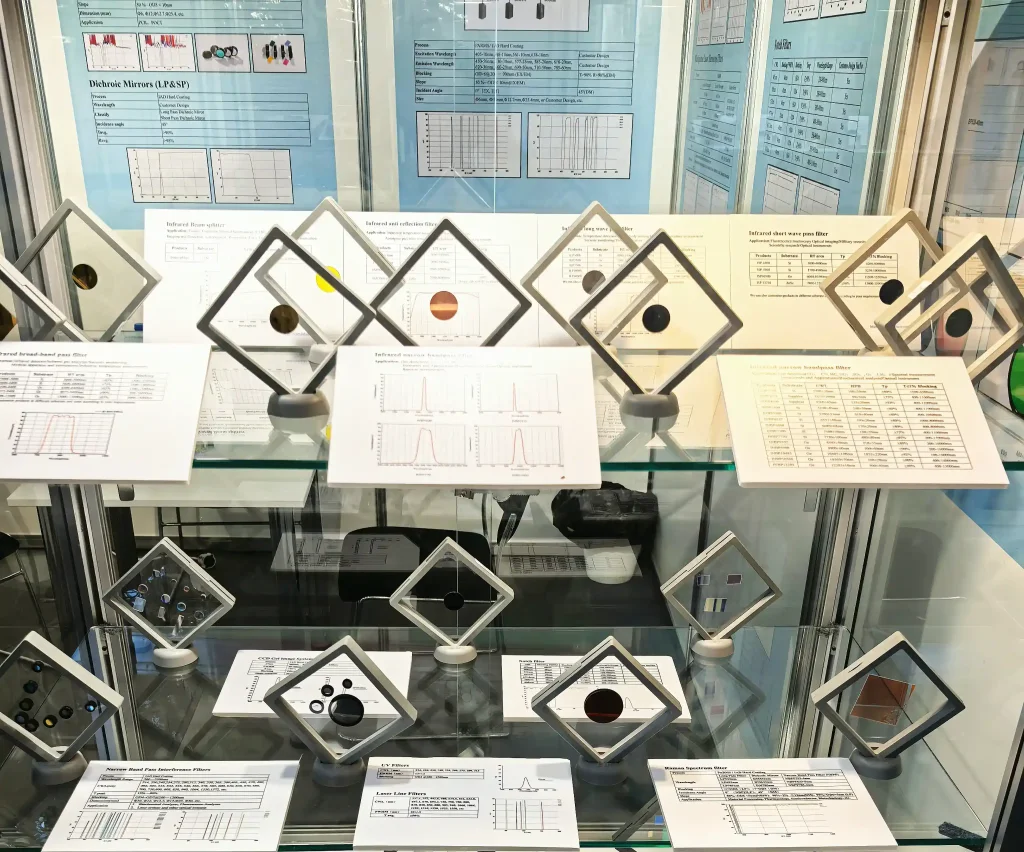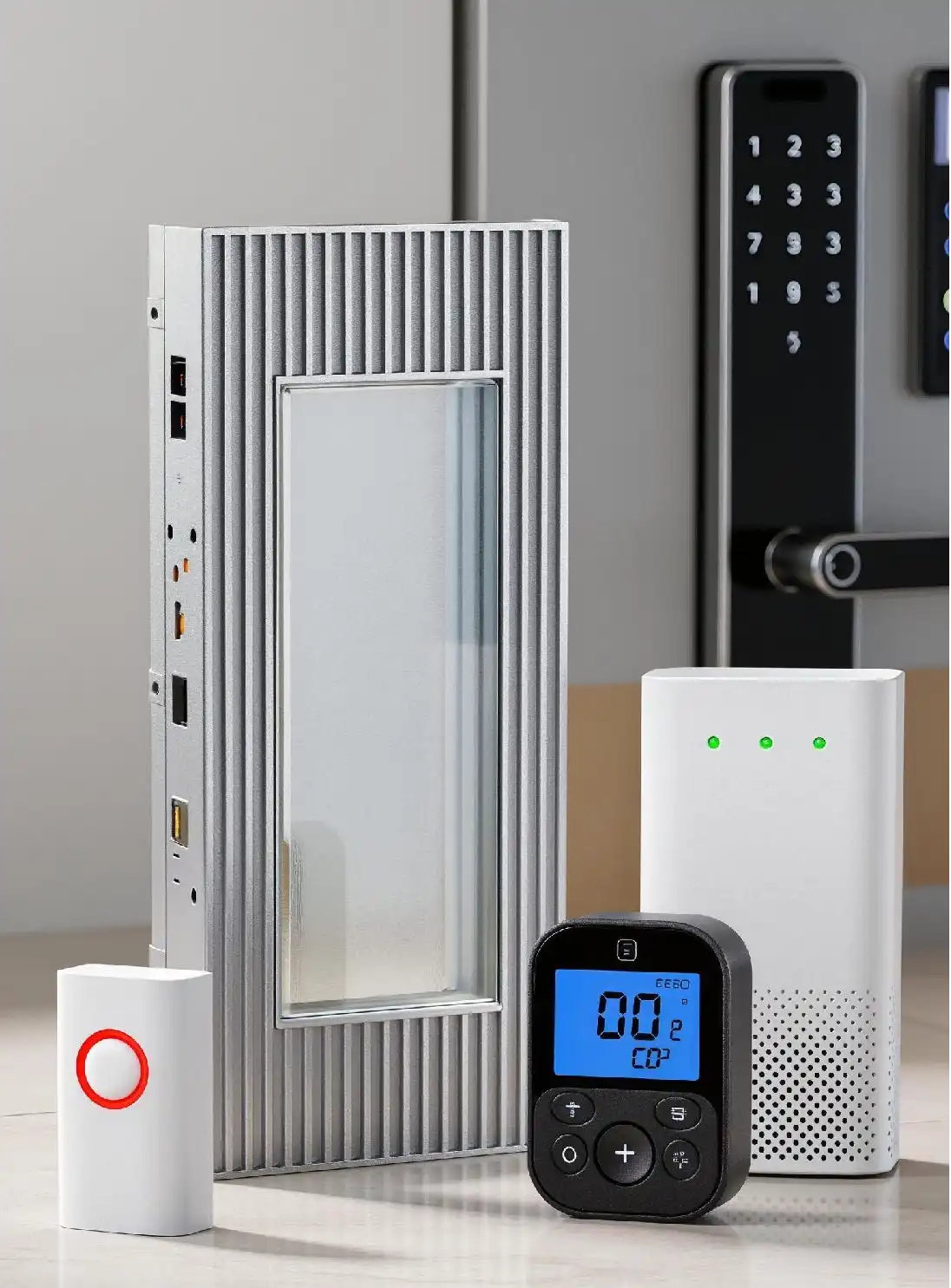A small device in hand quietly spots methane or CO2, invisible to the eye. That’s mid-infrared light doing its job, right around 4000 nm. This wavelength isn’t just a figure—it’s a key spot where molecules show their unique patterns.
Bodian Optical Technology Co., Ltd. has spent over 40 years building filters that grab these signals clearly. Here’s why 4000 nm is a big deal and how Bodian Optical’s products, like the ILP3000, ILP5500, and ILP10000, stand out.

What Defines Mid-Infrared Spectrum
Mid-infrared (MIR) sits in a special range of light. It connects visible light to longer heat waves. This is where detection tools really shine.
Wavelength Range from 3 to 8 Micrometers
The MIR band runs from about 3000 to 8000 nm. Materials like plastics, water, and gases soak up or give off light here. For instance, CO2 from a breath peaks near 4300 nm. Bodian Optical’s ILP3000 filter starts passing light at 3000 nm. It clears out shorter waves, giving clean data.
Key Role in Molecular Vibrations
Molecules wiggle like tiny springs. MIR light matches those wiggles perfectly. At 4000 nm, things like hydrocarbons and alcohols show clear patterns. In a 2024 lab test, a client’s spectrometer with Bodian filters found ethanol in water at 10 ppm. No mistakes. This happens because the light lines up with molecular movements.
Bodian Optical’s Specialized IR Filters
Bodian Optical makes filters built for MIR challenges. Their products, from long-pass filters at 3000 nm to broadband ones up to 10,000 nm, use materials like germanium and silicon. A defense company needed filters for drone heat cameras. Bodian sent prototypes in two weeks, hitting 90% light passage above the cutoff. Years of coating skills make this happen.
Why Is 4000 nm Crucial in Detection
Detection is about picking out what matters. The 4000 nm wavelength cuts through clutter, making it vital for real-world uses.
Optimal for Gas Sensing Applications
Gases like water vapor and sulfur dioxide grab light strongly at 4000 nm. Portable sensors use this range to spot pollutants fast. During the 2023 Canada wildfires, MIR tech tracked CO in smoke using 4.3-micron bands. The ILP3000, with its sharp 3000 nm start, blocks sunlight glare for accurate results.
High Absorption in Thermal Imaging
At room temperature, objects give off strong heat signals near 4000 nm—about 20% of a person’s heat curve. This is huge for night-vision gear. A security company testing Bodian’s filters saw images 30% clearer. Less glare from nearby light helped.
Enhanced Performance with ILP3000 Filter
The ILP3000 is a star player. It starts at 3000 nm and hits 93% light passage by 3500 nm, staying steady past 4000 nm. In a car safety project, it helped spot people in fog where regular light failed. With OD4 blocking below cutoff , it fits right into systems.
How Do Filters Block Unwanted Wavelengths
Filters are like guards. They let in wavelengths like 4000 nm but keep out the rest, keeping signals clear.
Long-Pass Design for IR Transmission
Long-pass filters use special layers to bounce back shorter light while letting infrared through. This stops visible light from messing up readings, which can cause 15-20% errors in gas tools. Bodian’s filters deliver clean MIR signals.
Rejection of Visible and Near-IR Light
Visible light (up to 1000 nm) and near-IR scatter all over, clouding MIR data. Bodian’s filters hit an optical density (OD) of 4 or better, stopping 99.99% of that noise. One case showed near-IR causing a 25% error in CO2 readings. Bodian’s long-pass filters fixed it fast.
Recommendation of ILP5500 for Precision
For tighter control, the ILP5500 is great. Its sharp 5% edge at 5500 nm works for systems targeting just above 4000 nm. A medical device company used it in breath testers, hitting 99% accuracy for acetone in diabetes checks. It comes in sizes from 12.5 mm to 50 mm, fitting many setups.
What Applications Benefit from 4000 nm
From labs to plants, 4000 nm powers tools that see the unseen. It’s key for smarter systems.

Environmental Monitoring Systems
Air quality stations use MIR to catch volatile organic compounds (VOCs). In cities like Beijing, 4000-nm bands spot ozone triggers early. Bodian’s filters are in over 500 field units. One client saw 40% faster responses during smog.
Medical Diagnostic Tools
Breath tests for diseases work well at 4000 nm, where markers like isoprene soak up light. The ILP10000 helped a portable device find lung cancer signs at 5 ppb in tests. Hospitals are grabbing these fast—one partner shipped 10,000 units last quarter.
Industrial Process Control with ILP10000
In refineries, spotting leaks or emissions is critical. The ILP10000 covers up to 10,000 nm, passing 92% of light from 4000 nm. A chemical plant cut downtime by 15% using drone sensors to catch methane leaks. It’s tough, handling -50°C to 200°C swings.
Why Select Bodian Optical Products
With so many suppliers, Bodian Optical shines through skill and custom work.
Advanced Coating Technology Expertise
Since 1978, Bodian has nailed vacuum coating and sputtering. Their Leybold Syrus 1350 keeps layers even to 1% across 150 mm wafers. No uneven spots ruin the signal.
Customizable IR Filter Solutions
Need an odd shape or angle? Bodian can adjust. An aerospace job needed curved filters for 45° light—transmission stayed at 95%. Sizes go from 5 mm to 200 mm, with extra coatings if needed.
Proven Reliability in High-End Uses
Certified for ISO 9001 and RoHS, Bodian’s filters meet NASA and military needs. One client got a 98% success rate on 10,000 units. Filters last over 10 years in rough conditions.
How Does ILP3000 Support Mid-IR Tasks
The ILP3000 is a go-to for MIR jobs. It’s flexible, strong, and gets results.
Cut-On at 3000 nm for Broad Coverage
Starting at 3000 nm, it grabs the near-MIR range, great for spectroscopy. In food safety, it spotted fake oils via 4000-nm peaks, improving accuracy by 25% over standard lenses.
High Transmittance Above 4000 nm
It hits 98% light passage from 4000 to 5000 nm, with less than 0.5% haze. Security cameras with ILP3000 see through smoke well. One test showed clear targets at 200 meters in dim light.
Ideal for Security and Surveillance
For drones or border scans, ILP3000 cuts visible light to focus on heat. A patrol system dropped false alarms by 35% using this filter. It pairs great with InGaAs detectors.
What Edges Do ILP10000 and ILP5500 Provide
These filters handle special needs, from wide range to exact cuts.
Extended Range to 10000 nm Coverage
The ILP10000 reaches far-IR, passing 92% light from 4000 nm to 10 microns. A power plant used it to check exhaust, catching a 2% efficiency drop early, saving big on fuel.
Sharp Cut-Off at 5500 nm Precision
ILP5500’s 10 nm shift at 5500 nm gives clean cuts. In Raman spectroscopy, it boosted signal clarity by 50% in a university lab by filtering laser lines sharply.
Versatile Integration in Scientific Research
Both filters fit cryostats or custom setups. In exoplanet studies, ILP10000 cleared water bands at 4000 nm, sharpening spectra by 20% in a telescope array. They work for multi-band systems.
In short, 4000 nm is the heart of MIR breakthroughs. It drives everything from tracking pollution to medical tests. Bodian Optical’s ILP series—ILP3000, ILP5500, and ILP10000—brings the clarity needed. Check out Bodian Optical for your next project.
FAQ
Q1: What Makes 4000 nm Stand Out in Gas Detection?
It’s where gases like CO2 and CH4 soak up light strongly. The ILP3000 blocks visible light, giving clear readings in smoky or bright spots, like factory stacks.
Q2: Can Bodian Filters Handle Custom Wavelengths?
Yes. Cut-ons from 3000 to 10,000 nm can be tweaked. A client needed 4200 nm for breath tests; Bodian sent prototypes in 10 days.
Q3: How Durable Are Bodian’s IR Filters in the Field?
Made on germanium, they handle -50°C to 200°C. A 5000-hour vibration test showed no failures in a tough industrial run.













